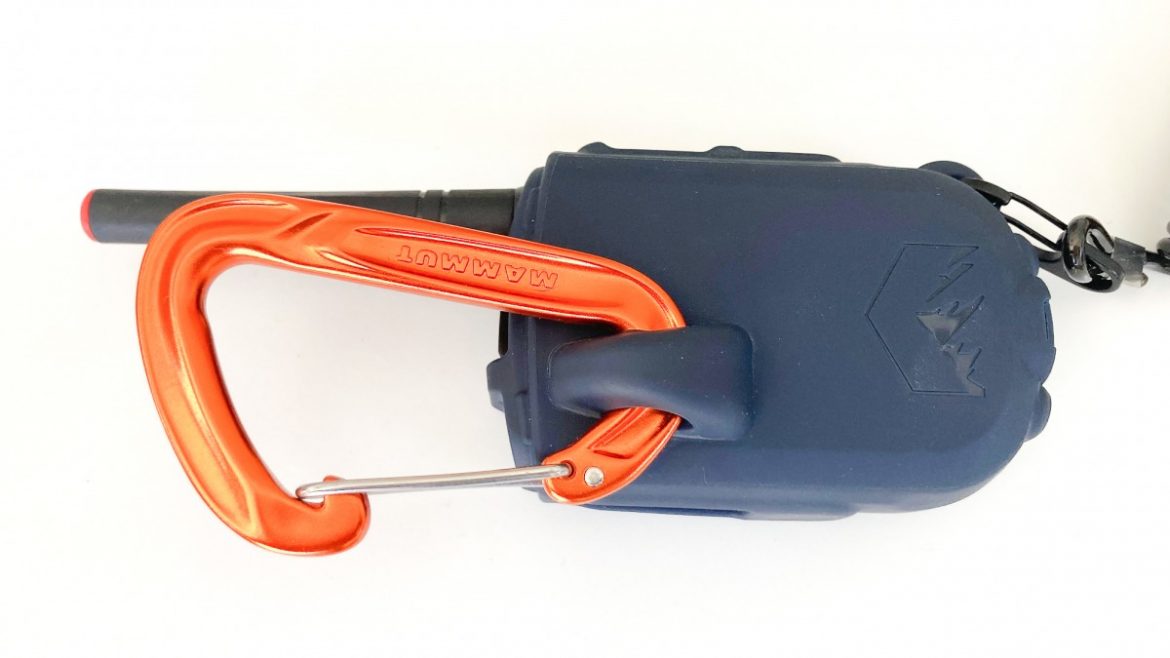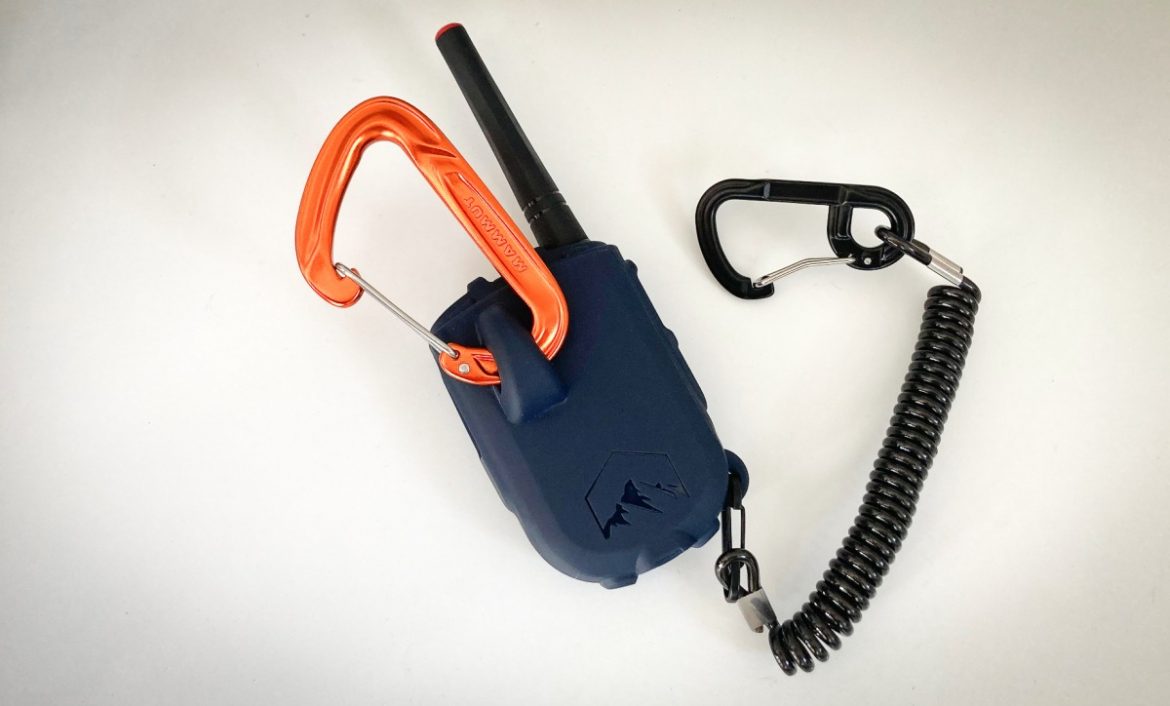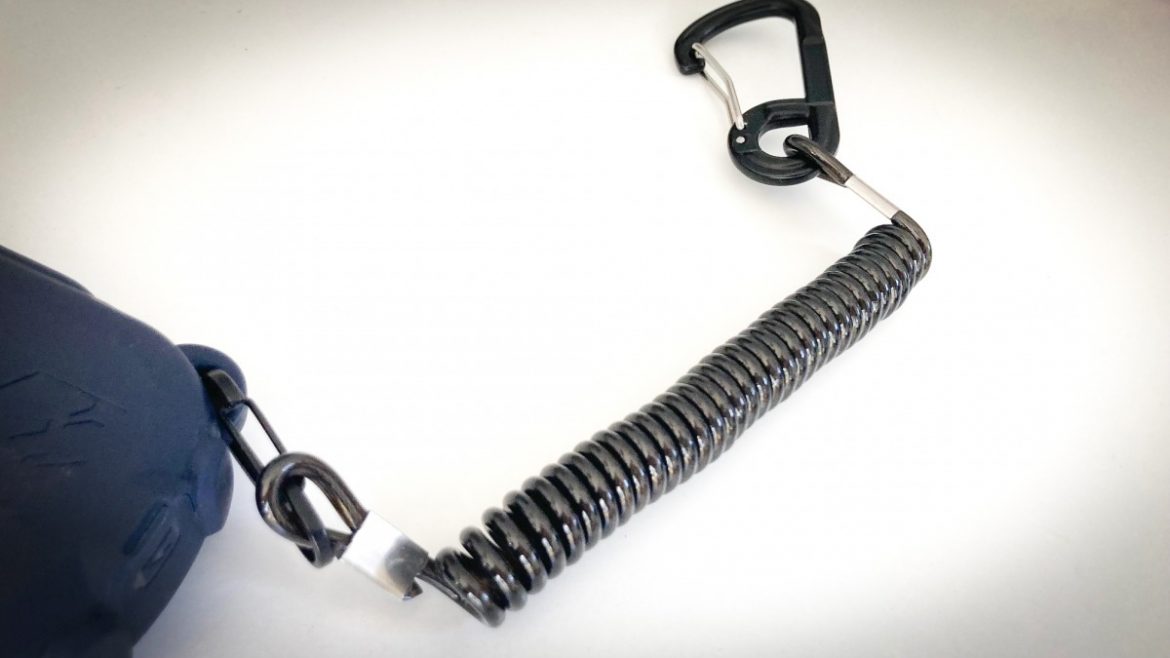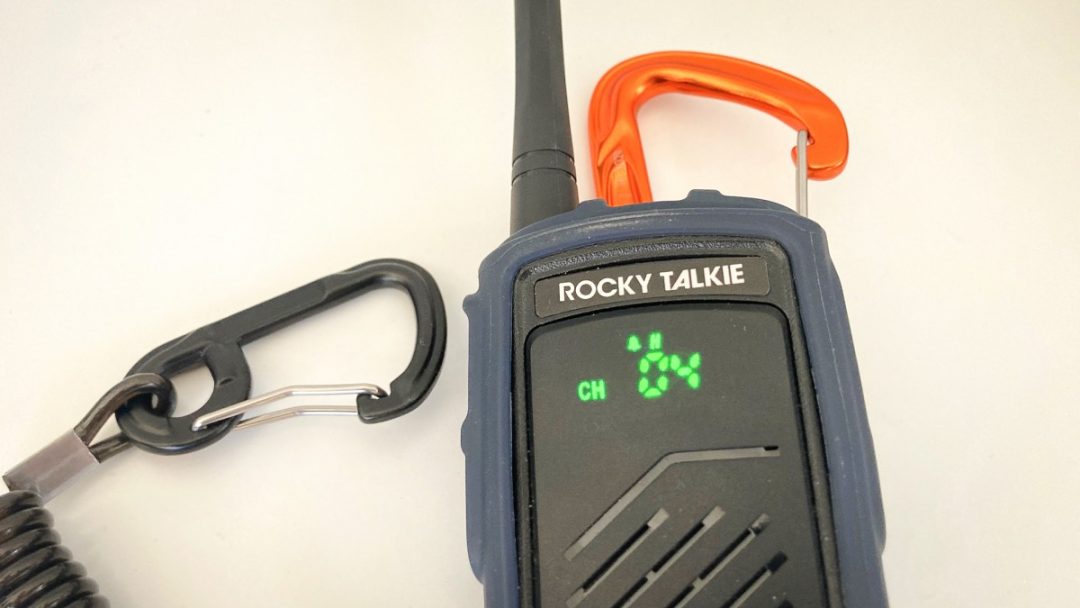
The Rocky Talkie features a shatterproof and easy-to-read screen. Rocky Talkie is a relatively new entrant into the backcountry two-way radio scene.
“Rocky Talkie” is, if nothing, a catchy phrase. And if you imagine the name foretells a review of a plasticky, gimmicky, cheap handheld radio, stop reading. These radios are at once compact and robust: A toy it is not.
For now, Rocky Talkie is a single product Colorado-based company. They sell the $95.00 eponymous Rocky Talkie – a radio in the FRS class of handheld two-way radios. Like all FRS radios including the industry-standard BCA Link 2.0 or ubiquitous Motorolas, you don’t need a license to operate the Rockie Talkie.
The basic stats present a simple handheld unit with five buttons, a minimal antenna, a legit Mammut carabiner, a burly backup leash in the event you drop it, and a savvy rubberized impact-proof case. The complete industrial design package weighs 220g and is 16.2 x 5.9 x 2.7 cm.
The BCA Link 2.0, by comparison, is a two-piece unit featuring a main body and attached speaker/mic and weighs approximately 340 grams. (We’ll have a review of the Link 2.0 in the next few weeks.)
Beyond exploring basic functionality, my first question is, will the Rocky Talkie flop around when attached to a backpack’s shoulder strap, and the downhill portion of the day ensues? Most FRS radios connect to a backpack shoulder strap with a spring-loaded clip, and they seem hardy enough and are time-tested. Rocky Talkies, on the other hand, a unit designed initially for climbers, secures with the Mammut biner. That biner clips through the removable (not sure who would do that) rubberized case via a molded loop. The biner interfaces snuggly with the molded loop. In other words, the radio does not flop around when swinging it by the biner. When attached to a backpack with only the Mammut biner, that’s a different story.
As I type this, I’m standing with a Blue Ice Kume 30 pack on – to be reviewed soon – trying to configure a way to keep the radio from bouncing.
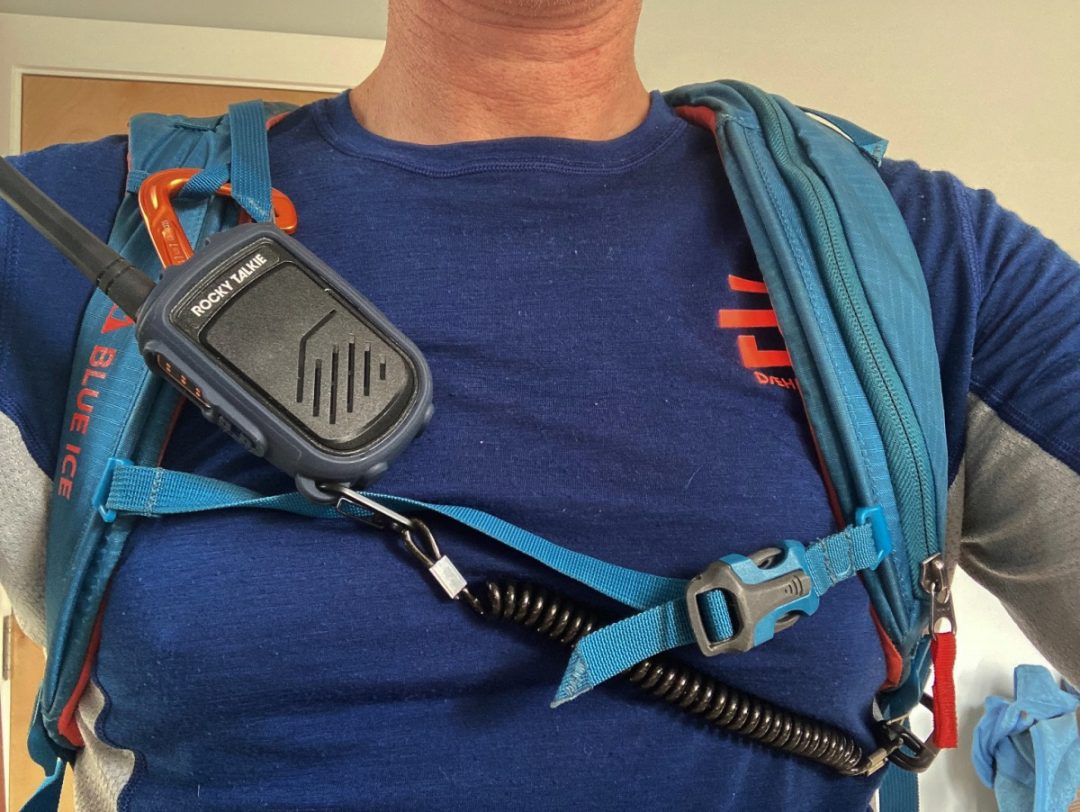
With the radio secured via the orange biner and the backup leash clipped to the opposite shoulder strap, no radio flop. I’ll be trying this setup with puffier clothes in the long-term review.
Creating no-bounce security is an easy fix. I have the Mammut biner clipped to the right shoulder strap, though the hydration guide, with the backup leash extending across my chest and securing to the left shoulder strap’s webbing. The fit is comfortably snug, with little, if any, radio bounce when hopping up and down. I can imagine several iterations of attaching the backup leash and eliminating any potential bounce; this is one solution.
I’ve got another fundamental question, is the transmission button operable with a big Alaska-worthy mitten. Check that box. I run cold – I pretty much stash mittens in my ski pack until the summer solstice. Wearing the Outdoor research Alti Gore-Tex mitts, think big, bulky, and toasty, engaging the transmission button is easy. If you are in doubt, the radio burps a loud beep when the transmission button is released, confirming that you are transmitting.
In terms of build, the front boasts, according to Rocky Talkie, a shatterproof screen. (We won’t be testing the shatterproof-worthiness.) The headphone jack and USB-C charging ports are weather sealed. As far as waterproofness, like the BCA Link 2.0, the Rocky Talkies are IP56 certified, meaning the electronics are protected from dust and “powerful water jets”; they are not submersible.
When you power up the Rocky Talkie, you get 2W of transmission power – the maximum for FRS radios. Two watts is similar to the power of a BCA Link 2.0. Reducing power to 0.5 Watts is easy and allows for longer battery life but weaker transmissions. The menu of channels, 128 deep, mostly default to high power transmissions. A user can, however, override a channel’s low or high power default. An H or L on the screen indicates whether the radio is using 2W or 0.5W.
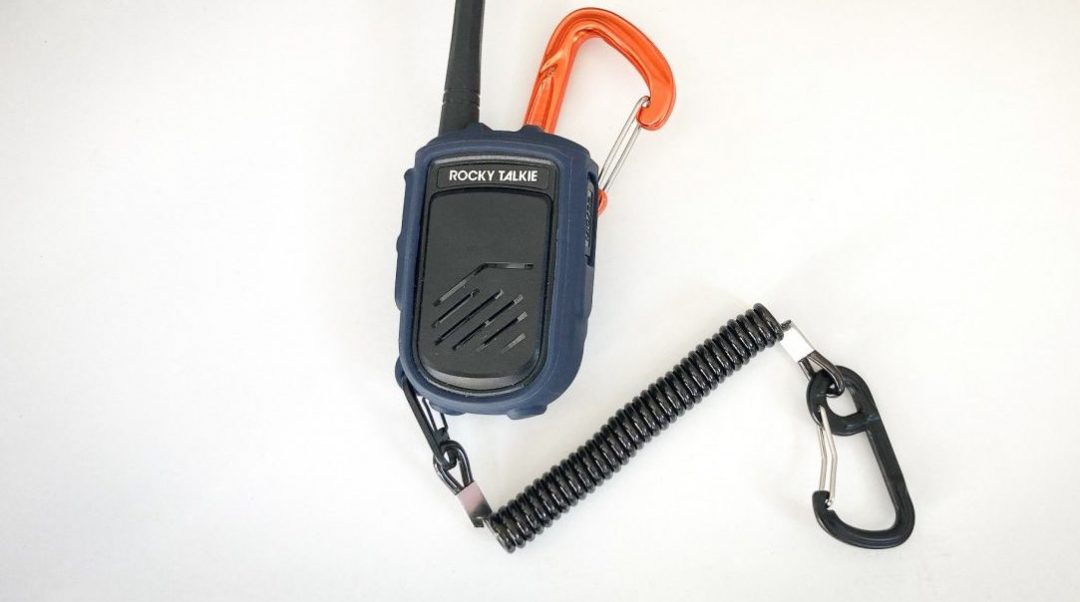
All the basics here in this handheld two-way radio from Rocky Talkie: 2 watts of power, 128 channels, weather and shock proof. We have more in our long-term review on range and basic functionality.
The deeper dive into channels looks like this: Channels 1-22 occupy the allowable FRS frequencies, with no privacy codes. (You can, however, add privacy codes to channels 1-22 on the fly.)
If you and your partner are using Rocky Talkies, finding a private channel is easy. Channels 23-128 are preset with privacy codes, allowing quick connectivity on a private channel.
The Rocky Talkies feature a channel scan button. This allows skiers to determine if groups are in the same ski zone and are using channels 1-22 to communicate. If the radio does not pick up any active channels, this does not guarantee your group has the zone to itself.
Most groups, however, arrive with a mix of radio brands. Rocky Talkies interface with BCA, Motorola, and other FRS radios. Radio manufacturers recommended you check their respective tech manuals to determine channel compatibility.
For compatibility between BCAs and Rocky Talkies, you must use channels 1-22. Once you have selected a channel, add a privacy code, the 121 privacy codes are standard between the two brands. After completing that two-step process, you have a sure-fire way to allow inter-brand radio communication.
A rechargeable lithium-ion battery powers the Rocky Talkie. The battery is easily replaceable. However, according to Rocky Talkie, you must reach out to customer support to discuss replacement options. In our long-term review, we’ll have more information on battery life and transmission range in specific types of mountainous terrain. For now, with a Rocky Talkie set, I can communicate clearly with my neighbor, about three city blocks away, as we banter about potential snow up high and his tragic love affair with his hometown Portland Trailblazers.
Unlike the BCA Link 2.0, Rocky Talkies do not offer access to a weather channel. And the headphone jack takes a two-pin K1 connector.
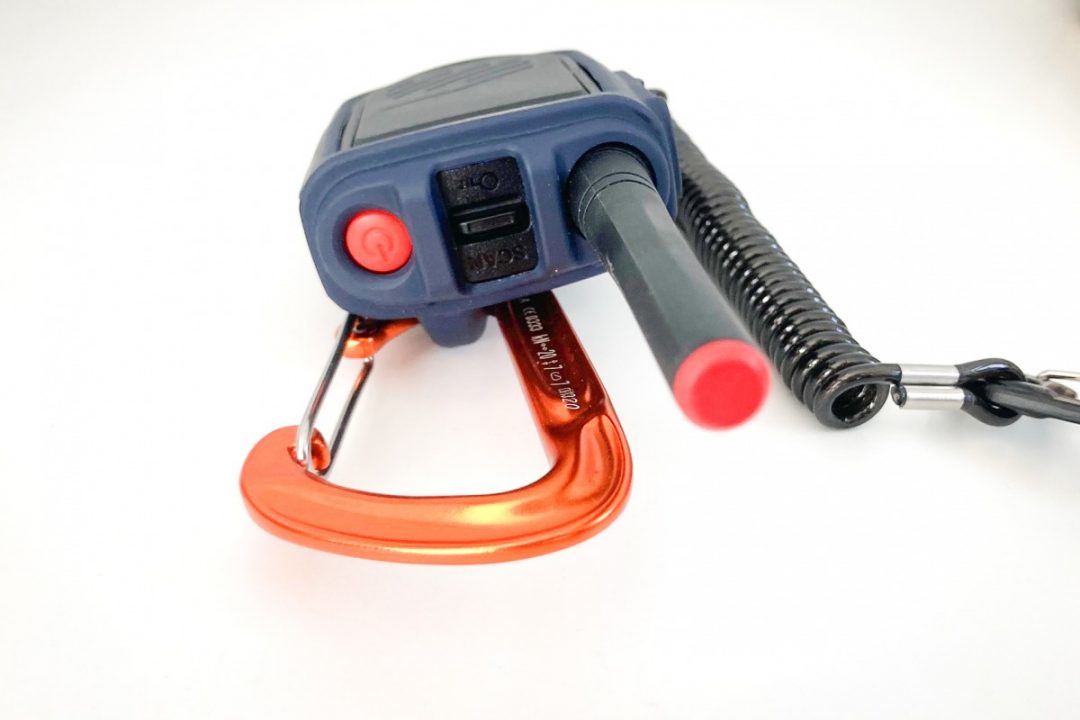
Top view of the Rocky Talkie and the scan/lock switch and red power button. These units can transmit at 2W or 0.5W.
These compact radios come with a two-year warranty and retail for $95 per unit, and $190 for a pair.
One last note: like the other popular FRS setups, these are two-way radios. They are not devices intended to call for emergency help – the ranges are likely ineffectual in rugged terrain, or specific emergency channels are unmonitored. You’ll still need an inReach type device for that.
More to come.
Jason Albert comes to WildSnow from Bend, Oregon. After growing up on the East Coast, he migrated from Montana to Colorado and settled in Oregon. Simple pleasures are quiet and long days touring. His gray hair might stem from his first Grand Traverse in 2000 when rented leather boots and 210cm skis were not the speed weapons he had hoped for. Jason survived the transition from free-heel kool-aid drinker to faster and lighter (think AT), and safer, are better.

